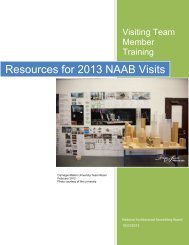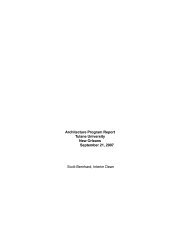NAAB Architecture Program Report (APR) 2013 - Tulane School of ...
NAAB Architecture Program Report (APR) 2013 - Tulane School of ...
NAAB Architecture Program Report (APR) 2013 - Tulane School of ...
Create successful ePaper yourself
Turn your PDF publications into a flip-book with our unique Google optimized e-Paper software.
<strong>Tulane</strong> University<strong>Architecture</strong> <strong>Program</strong> <strong>Report</strong>September <strong>2013</strong>Over the course <strong>of</strong> five years, this helped in guiding and explaining our direction during a time <strong>of</strong>significant change within the <strong>School</strong> <strong>of</strong> <strong>Architecture</strong>. The current update involves a re-assessment <strong>of</strong>where we are heading as an institution and addresses the question <strong>of</strong> where we want to be in fouryears and beyond.The Next Four Years – Dean’s Vision StatementI envision a <strong>School</strong> that will be recognized among the top ten programs in architecture, real estatedevelopment and preservation, and a national leader in social innovation and social entrepreneurship.We will accomplish this through a series <strong>of</strong> strategic steps that leverage our current strengths andfurther distinguish our programs at both graduate and undergraduate levels. By focusing on theessential role <strong>of</strong> “design thinking” and innovation while expanding our students’ range <strong>of</strong> consideration,the <strong>School</strong> will continue to be widely recognized as a leader in community engagement and as aprogram that increasingly exemplifies the extraordinary power <strong>of</strong> social entrepreneurship to create abetter and more engaged community. Key to this agenda is the way the <strong>School</strong> will continue toembrace excellence through diversity. We aim to have an intellectually, ethnically, racially, andgeographically diverse faculty with increasing diversity, including economic diversity among the studentbody as well. Issues <strong>of</strong> diversity connect directly to our relevance to contemporary society, in whicharchitects, preservationists, and real estate developers contribute their pr<strong>of</strong>essional expertise.As a framework, we will uphold three primary concepts in our academic mission and in the values weinstill in our students:1. Educating students in the abiding cultural and social roles <strong>of</strong> architecture, preservation, andreal estate development by providing a well-rounded, humanities-based education withdiscipline-specific coursework;2. Preparing future pr<strong>of</strong>essionals through continually assessed and updated coursework indesign, building technology, and pr<strong>of</strong>essional concerns, with an emphasis on critical thinking;3. Instilling a sense <strong>of</strong> responsibility and ethical conduct through civic engagement.By upholding these three concepts, student work will be more fully recognized for its excellence, bothnationally and internationally. Faculty productivity and measurable influence will increase dramaticallyin various forms, including traditional academic scholarship, excellence in design and creative work,teaching, and locally-based community engagement and public service. The narratives describing thisprocess will be compelling tools in raising awareness and in attracting students to <strong>Tulane</strong>. New Orleanswill continue to be a major laboratory for the <strong>School</strong>’s work both in terms <strong>of</strong> pedagogical focus andtangible community engagement, and there will be increasing opportunities to explore issues beyondNew Orleans as well.In four years, the <strong>School</strong> will see a major expansion in resources to support the ambitions <strong>of</strong> studentsand faculty more vigorously. This will be the result <strong>of</strong> robust and sustained “development” efforts,including a Capital Campaign for Innovation and <strong>Tulane</strong> Sustainable Strategies totaling $30 million ormore. It is hoped that the Richardson Memorial Hall renovation and addition will be completed by 2018.This project will become an exemplar for our students and faculty as a learning laboratory that willinclude traditional functions <strong>of</strong> an architecture school and an added role as the symbolic center forinnovation and entrepreneurship under the rubric <strong>of</strong> <strong>Tulane</strong> Empowers. The project will also serve asroad map for other historic projects on <strong>Tulane</strong>’s campus and beyond, demonstrating ways to buildprogressively with ambitious, sustainable goals and with deep respect for a structure’s physical, historicand cultural significance.“Every time a student walks past a really urgent, expressive piece <strong>of</strong> architecture that belongs to hiscollege, it can help reassure him that he does have that mind, does have that soul.”Louis Kahn10














